From Empire To Fall: The Development Of The Eldar Part 3
June 24, 2013 by crew
After a trip on the Nile Jes Goodwin sculpted five Eldar Models. These were the beginnings of a redesign that would establish the Eldar identity that endures today as the Craftworld Eldar in both design and lore. Looking at these models you can clearly see design elements that would go on to form the Dire Avenger Aspect warriors. The crests and standardised shuriken catapults as well as a move away from the chain mail style mesh armour that had comprised most Eldar models up until this time.
What Jes saw on that trip was to influence his designs for the Eldar even further. In 1991 White Dwarf 127 a huge chunk of the magazine was given over to the new background and army list for the Eldar. The style and layout of this article moved away from what had previously been used for army lists and would form the basis of the Codex layout. Taking the story of the Fall that has been mentioned previously with the introduction of the Harlequins, Eldar lore was expanded, mixing Celtic and Egyptian mythology to flesh out and establish the Eldar as a distinct part of the Warhammer 40,000 universe.
The Eldar home world was gone along with the thousands of Core worlds that comprised their galaxy spanning empire. Where they hung in space now exists the Eye of Terror, the vast warp/real space overlap from which are vomited forth the legions of Chaos. The Eldar themselves were now a dying race scattered amongst the stars, roaming the galaxy in their Craftworlds, the last remaining outposts of true Eldar culture.
This catastrophe was linked to the Eldar’s psyche. The Eldar mind is geared more towards extremes. Though an Eldar may feel love, hate, sadness and joy they have the potential to experience these emotions at extreme levels undreamed of to a human. An Eldar’s natural inclination towards extreme emotional states was to be the downfall of their ancestors. In a universe where physical labour was unnecessary and their power unquestioned the Eldar found time to indulge their every whim. Hedonism and cruelty drew more and more Eldar towards depraved cults and their once great civilisation devolved into anarchy.
Some Eldar foresaw this impending doom. They denounced Eldar society and fled to virgin worlds where they would live a simpler life in tune with their environment and nature. Later migrants realised too late what was happening to their race and hastily organised an exodus aboard gigantic ships that would later become Craftworlds.
It all ended in a moment. The Eldar are a psychic race. Even the least trained Eldar are able to manifest weak psychic phenomena. This mostly takes the form of telekinesis or telepathy. The decadent and depraved echoes of the Eldar race’s self-destruction had coalesced in the warp. Slowly these nascent emotions grew in potential until with a birth scream that shuddered through the unreality of the warp and in the reality of the material plane the Chaos God Slaanesh was born.
Across the Eldar Empire on core worlds, colonies and on those Craftworlds that had not fled far enough away to escape, the souls of every Eldar were torn from their bodies to feed the emergent hunger of Slaanesh. Across countless tracts of space Eldar collapsed into withered husks as their souls were consumed. Even the Exodites and the furthest flung Craftworld Eldar collapsed in agony as their nemesis was born, some dying of terror where they stood.
The core of the Eldar Empire collapsed into the Warp. What was left behind was the Eye of Terror a place where the Warp bleeds into the material universe and where gods and daemons hold sway.
From this point on the Eldar were a dying race. Those that survived were too few and too scattered to form a cohesive whole and though able to communicate and meet through the webway the Eldar were slowly drifting towards extinction. Though some Craftworlds returned to the now dead Eldar worlds to rescue those that had managed to stay sane they were forced to retreat or be caught within the Eye. Four Craftworlds were named but not given any particular history or flavour. These were Ulthwe, Saim-hann, Biel-tan and Iyanden.
The Fall had a profound effect on the remaining Craftworld Eldar. Spiritually they were broken. The Eldar gods were defeated in the warp and consumed by Slaanesh. Only two survived. The first was Cegorach the Great Harlequin who escaped to the webway, the vast realm of interlinked tunnels that connected the Eldar to each part of their far flung empire and allowed quick travel between points separated by untold light years. The second was Kaela Mensha Khaine, the bloody handed god of murder. Khaine fought ferociously against Slaanesh but in the end could not prevail. Slaanesh though triumphant was unable to destroy Khaine so shattered his essence and drove him into the material plane. The shards of his being came to rest within the heart of each Craftworld where within a chamber sits a giant Avatar of Khaine made of iron upon a throne, cold and empty until times of war.
With their gods dead the Eldar slowly began to realise they faced another peril. As Eldar died their souls were not being reincarnated in new bodies or absorbed into the sea of souls. Upon investigation Eldar seers discovered that when an Eldar died its soul entered the warp and was hunted down by Slaanesh to be tortured until the Prince of Pleasure grew tired of its sport and consumed it. Nought but agony and eventual oblivion awaited the Eldar in the afterlife.
To combat this fate every Eldar would wear a Waystone, a special kind of spirit stone. Spirit stones it was told were gifts from the Eldar god Isha the mother goddess as a way for her to communicate with her mortal children and allowed them to conduct and store warp energy for beneficial use. When an Eldar died their soul would be captured by the Waystone before being cast into the Warp. A large gem would be sculpted onto the breast of all Craftworld Eldar to represent their Waystone as it is an Eldar’s most precious possession. Waystones would then be used to transport the soul home where it would be installed in the Craftworld’s infinity circuit.
At this point some ret-conning comes in. Previously an infinity circuit was just that, a circuit board with an Eldar memory engram imprinted into it. These were used to pilot Eldar vehicles and computers. Now an Infinity Circuit was the core of a Craftworld. Craftworlds like all Eldar technology were created from Wraithbone. This was an incredibly resilient psycho-plastic which could be moulded and shaped by psychic impulses. It was also able to conduct warp energy thereby allowing the storage of Eldar souls. Before being put into an infinity circuit was seen as a huge sacrifice for an Eldar, a waking nightmare. Now it was a vast communal repository and safe house from the predations of Slaanesh, the final peaceful resting place and refuge for dead Eldar.
Eldar souls can move freely throughout the Craftworld through the Infinity circuit and can provide power and controlling intelligence for various Eldar machinery. By re-entering a Waystone the Eldar would be able to pilot Wraithguard. These were not Wraithguard as we know today but probably referred to the dreadnoughts and spirit warriors that at this time comprised part of the Eldar force.
Having found a solution to the problems of life after death the Craftworld Eldar bent their minds to preventing a repeat of the mistakes of the past. Wanton embrace of the Eldar psyche could not be allowed to run rampant through the remains of Eldar society. The solution was The Path.
Eldar have exceptionally long life spans and can live thousands of years. Though not conceived of yet the Ulthwe Farseer Eldrad Ulthran is said to have attempted to warn the Emperor of Horus’ eventual betrayal ten thousand years ago! Living so long gives an Eldar plenty of time to perfect many skills. To focus an Eldar’s mind they choose a Path. Each Path relates to a role within society be it gardener, waiter, politician, warrior or seer. An Eldar upon a Path dedicates themselves solely to perfecting that role. When an Eldar believes they have reached the pinnacle of what they can achieve on a path they will abandon it for another.
The two most relevant paths in games of Warhammer 40K are the path of the warrior and the path of the seer. Jes Goodwin created six original warrior aspects for Rogue Trader Warhammer 40K. Each of these paths represented one of the aspects of Khaine in dealing death. So that Eldar can cope with the emotional fallout of killing another being they are able to subsume their will to Khanie by ritually donning their armour within their Aspect’s temple shrine. Once the warrior dons their helm they become the aspect, no longer themselves they are able to perform what they need to upon the battlefield without being tainted by the emotions of the act.
Aspect shrines are present on all the craft worlds though not all Craftworlds contain every shrine and some are unique to certain Craftworlds. The aspects given in the article in WD127 were the most common of the aspects. Aspect shrines were guarded by Exarchs. Any Eldar who became too enamoured with the Path they were on would become lost to it. They would become perfect examples of their craft but in so doing would lose their individuality. For the warrior path these Exarchs became one with the aspect they represented, their waystone being added to the Exarch armour they wore upon their death to allow their knowledge and experience to become part of the next wearer rather than be added to the infinity circuit. In game Exarchs could choose a number of specialist abilities that would enhance them further.
Each of these aspects was highly specialised and suited to a particular role. Dire Avengers were the most numerous of the Aspects and their shrines were to be found on every Craftworld. Embodying Khaine in the aspect of noble warrior they were skilled in the use of the Eldar’s now signature weapon, the Shuriken Catapult. Fire Dragons went to war with melta guns able to reduce any foe to atomised particles. Howling Banshees were close combat troops whose helmets projected a deathly psychic scream at their enemies rendering them senseless and ready to be cut down by the Banshee’s power swords. Striking Scorpions were a heavier form of close combat aspect who wore mandiblasters, helms that spat streams of energised crystals into the faces of their enemies. Those not killed by these stings were hacked apart by the Scorpion's chainswords. Swooping Hawks wore wings that allowed them to fly high above the battlefield dropping grenades from their thigh mounted launchers. The final aspect were the Dark Reapers representing Khaine as the bringer of death. Ranged specialists the Dark Reapers were all armed with missile launchers!
The path of the seer only contained two units but these were perhaps the most powerful. Warlocks were seers who had walked the warrior path at some point before and their bellicose nature directed the warp craft they would study. In Rogue Trader psychic powers were manifested by spending psi points which were allocated to the model in their army entry. Eldar psykers did not draw energy directly from the warp as humans and other aliens might do, this would be suicide as Slaanesh would use this opening to consume their souls. Instead Eldar psykers would channel energy through runes made of wraithbone which they would keep on a pouch on their belt. Check you Eldar psykers, they all have a pouch of runes! These runes would burn up and disintegrate if too much warp energy was channelled through them acting like a psychic fuse.
If an Eldar dwelt too long on the path of the seer they would become trapped like the Exarchs and become a Farseer. A Farseer reads the runes of fate to divine the future and steer the Craftworld away from harm. In battle the Farseer was and still is one of the most powerful psykers in 40K. A Farseer uses their knowledge of the future to influence the course of a battle, guiding shots to their mark or steering Eldar away from blows that would prove mortal. They can even turn their enemy’s minds to mush with a glance.
To complement the elite nature of the aspect warriors were the Guardians. A militia made up of citizens mobilised in times of need or where the Aspect Warriors alone cannot prevail. As Eldar lives are precious and cannot be squandered in battles of attrition they tended to be used for garrison duty. Guardians also piloted jet bikes one of the few vehicles available to the Eldar at this time or else crewed heavy weapon platforms armed with mostly imperial heavy weapons.
The final new unit was Kaela Mensha Khaine himself, or rather his Avatar. When war calls and the Eldar bend their mind to violence the antagonistic thoughts are absorbed by the wraithbone structure of the Craftworld and diverted to the Avatar chamber. There the Exarchs of the various temple shrines gather in their war panoply. With them stands the Young King, an Exarch chosen to bear the title each year. Their naked body is inscribed with runes of power in their own blood before the Siun Daelle, the Doom That Wails, a weapon of bound fury and hate which can take any form is placed in one hand and in the other the Cup of Criel which contains the Young King’s own blood. In game the Avatar would have special immunities to weapons based on heat. A being with magma for blood is not going to be concerned with fire!
The Young King will enter the chamber of the Avatar wherein he is locked. Hymns of blood are taken up by the Exarchs and a choir of seers as the doors begin to glow with an internal heat.
As the hymns reach a peak an agonised death scream can be heard from behind the locked portal. A slow and steady reverberation will begin like the beating of some infernal heart growing in strength before the doors of the chamber are thrown open and out steps the Avatar of Khaine, molten metal blood visible beneath his cracked iron skin, his footprints aflame with the heat of his passing. In one hand he holds the Wailing Doom, the other constantly drips blood. Where the Avatar walks war follows and his Aspects bring doom to the enemies of the Eldar.
This huge influx of new units would allow Jes Goodwin to standardise the look of the Eldar. Curved lines with blisters liberally scattered across armour that could be painted as gems. High pointed and sometimes crested helms would give a distinctive silhouette to Eldar warriors. Rune like hieroglyphs would be sculpted and painted onto the models to give them a unified look.
Though I would not get into Warhammer 40K for another few years the changes that were wrought in WD 127 would be what would kindle my interest in the Eldar and makes them my main army even now.
The reimagining of the Eldar would appear as Rogue Trader Warhammer 40,000 was moving further away from its games master led origins and more towards a skirmish battle game between two or more players who would run the game themselves. More and more rules revisions would find their way into the pages of White Dwarf until 1993 where these rules would be collected, tidied up and presented in the newly released Warhammer 40,000 second edition.
In the next article we will look at how the Eldar were refined and had to cope with being an army who were trumpeted for their speed but who had to walk everywhere, most likely in a paint scheme with far too much red.
Lee Trayler
Supported by (Turn Off)
Supported by (Turn Off)
Supported by (Turn Off)




































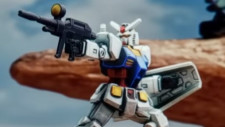




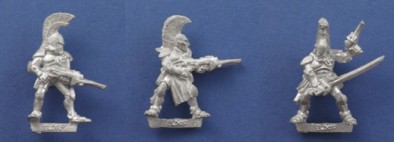
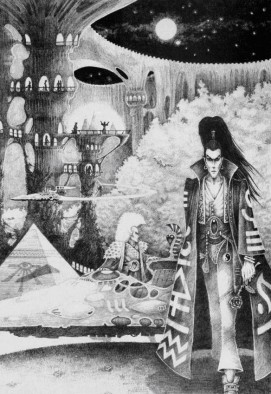
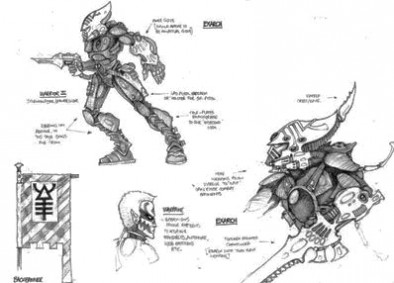
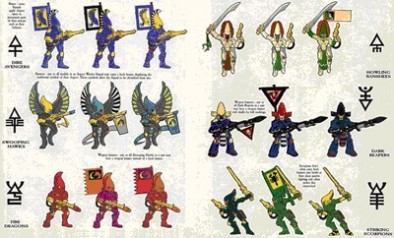
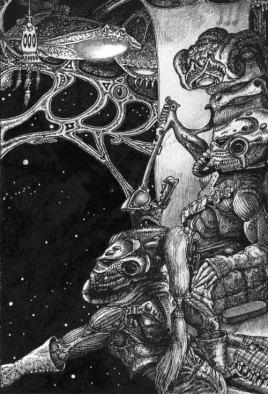
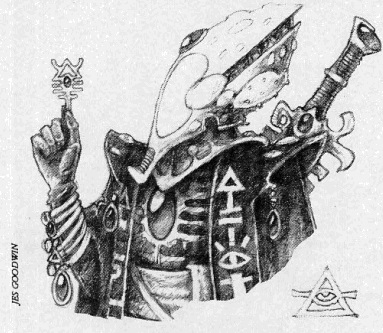


































Glorious. I’ve still got the 40K Compilation book where those sketches were re-printed. The Eldar really are beautiful. They were the first opponents of my blood angels back when we used books as hills.
Nostalgia overload and a really enjoyable read.
Was WD127 really 1991?!?!?!? God I feel old, that was my second ever WD (after a year playing hero quest). Just before then I had bought Rogue Trader and was looking for an army soon after that WD I started to build my Harliquins and Eldar.
I’m enjoying Eldar week and Lees articles but we got to keep a lid on it we don’t want everyone playing Eldar.
The Eldar have always had a very Japanese Zen feel to them for me.
Enjoyed this article. Are the mini pictures from your own collection?
No though I am on a Rogue Trader era collecting run at the moment. I used to have that Avatar but sold him long ago.